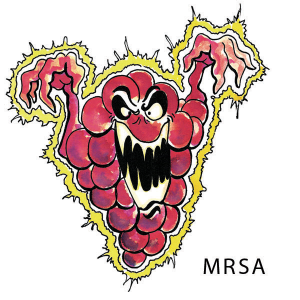16 Sep Back to School with MRSA
Bath or Shower? Morning or Evening?
The weather is changing and the days are shortening. Most students and teachers are now back in the classroom and the daily routines are reinstated in most households. MRSA (Methicillin-Resistant Staph aureus) loves this time of year and the school environment. An emphasis on good personal hygiene is the most appropriate technique for prevention of MRSA infection. But just telling students and teachers and athletes to, “wash your hands” and “practice good personal hygiene” doesn’t translate into compliance or competency. There are lots of questions to address as we try to “practice good personal hygiene”. Here’s one: Which is better, a bath or a shower? Most of us have a preference based upon the family practices, schedules and routines when we were growing up and our current available plumbing resources.
My opinions are based upon principles of infection prevention and personal logic and reasoning. There are pro’s and con’s of each method of cleaning our bodies and removing MRSA and other skin microbes that cause infections and unpleasant odors:
Tub Bath
Pro:
The bathing experience reduces stress due to the relaxation effect of hydrotherapy
Con:
Requires large volume of water
Con:
Even though the concentration is generally small, bath water becomes contaminated with soap, chemicals and
nanobugs. Generally, this is not a problem except when women take long baths and the contaminated water
backs up into the urethra causing irritation and infection (especially in young girls). Bubble baths and other bath
additives increase the risk.
Shower
Pro:
The downward force of the water in the showers allows the soap and most of the nanobugs to be washed off
the skin and sent down the drain.
Pro:
The stimulation of the streams of water on the body during the shower experience are invigorating
and can wake you up.
Con:
The floor of a shower can easily harbor nanobugs like the fungus causes “athletes’ foot’.
Con:
A shower can spoil a hairdo with the steam and splash and splatter of the water.
Actually, I think the Japanese have the best system for bathing that accomplishes all the advantages of both. The Japanese bathtub is small but deep. The procedure/experience begins with a washing of the body while you are sitting or standing in the tub. The drain is left open and a hand-held sprayer is used to thoroughly rinse the soap and nanobugs off the skin and down the drain. Then the drain is plugged and the tub is filled with warm water to shoulder level. Then the bather relaxes in the clear water for as long as time permits.
The next question is when to cleanse the body – in the morning upon rising – capitalizing on the stimulation of the shower method or at the end of the day with the relaxation benefit of the tub baths before sleeping. I encourage parents of school-age children to bathe the children daily before they go to bed so that all the nanobugs they have collected on their body during the school day and/or after school athletics don’t get to “sleep over”.








Sorry, the comment form is closed at this time.